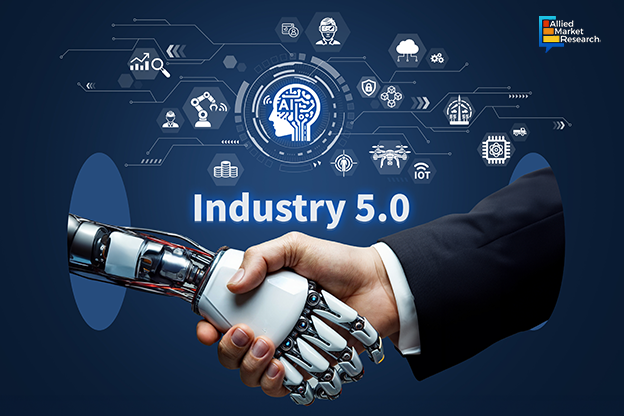Industry 5.0: A New Era of Human-Robot Collaboration and Sustainable Manufacturing

10 Jul
2024
Highlights
- Introduction
- Role of cobots in Industry 5.0
- The dynamic potential of Industry 5.0
- Technological advancements in Industry 5.0
- Recent developments in the industry
Industry 5.0 involves humans collaborating with robots and smart machines, aiming to enhance productivity and efficiency through technologies such as big data and Internet of Things (IoT). This transition blends human skills with automated systems, enhancing the efficiency of Industry 4.0 with a more personalized touch.
In manufacturing settings, robots have conventionally handled repetitive or hazardous tasks, such as the loading and unloading of heavy materials in warehouses, as well as painting and welding in automobile plants. Workplace machines are becoming intelligent and interconnected, and Industry 5.0 seeks to integrate these cognitive computing abilities with human intelligence and ingenuity in collaborative operations.
The advent of cobots for a safe and interactive work environment
The Industry 5.0 industry has experienced significant growth driven by the rising adoption of collaborative robots, commonly known as cobots. These robots are essential in defining Manufacturing 5.0, a key element within the larger framework of the 5.0 Industrial Revolution. Industrialization 5.0 highlights a transition where the focus shifts to human-robot collaboration, promoting a more synergistic and efficient work environment.
Collaborative robots, or cobots, are developed to operate with human workers, promoting smooth cooperation and improving overall productivity. Unlike conventional industrial robots that work in isolation, cobots are empowered with advanced safety features and sensors, creating a safer and more interactive workspace. This heightened emphasis on human-robot collaboration effectively addresses challenges formed by dynamic and complex manufacturing processes.
Balancing innovation and impact
Attracting and retaining a talented workforce has become increasingly challenging for companies, and Industry 5.0 aims to tackle this by offering a more dynamic and stimulating work environment. This approach enhances employee satisfaction and loyalty and contrasts with roles solely centered on machine operations. However, incorporating sustainable practices is essential for businesses, particularly industries that consume significant resources and energy. Industry 5.0 meets stakeholder expectations and enhances the attractiveness of a business to potential employees, consumers, and investors.
Prominent contributors to the Industry 5.0 evolution
Advanced technologies such as IoT, predictive analytics, and machine learning allow manufacturers to continuously monitor their units in real-time, generating large volumes of data. Manufacturers utilize this data by integrating AI tools to uncover valuable patterns. AI in manufacturing enables manufacturers to analyze customer behavior to predict demands, detect anomalies in production processes, achieve various other efficiencies, and automate analytics.
Moreover, the manufacturing industry relies heavily on IoT for its substantial benefits. IIoT is designed to enhance efficiency, meet the unique requirements of manufacturing, enable predictive maintenance, reduce errors, improve safety, optimize production lines, and more. The adoption of these technologies in manufacturing aligns with the principles of Industry 5.0, which promotes a harmonious balance between human-centric practices and technological progress.
Frontrunners transforming the manufacturing operations with Industry 5.0
Industry 5.0 emphasizes the need for organizations to prioritize resilience and sustainability. Companies are shifting from focusing on efficiency and profit to developing adaptable, flexible systems capable of withstanding disruptions. There is also a heightened emphasis on moving toward net positive sustainability objectives and reducing environmental impact.
Accel Selected 8 Startups for Industry 5.0 Solutions as part of the Atoms 3.0 accelerator program
In April 2024, a prominent venture capital firm, Accel, selected eight startups specializing in AI and Industry 5.0 solutions for its Atoms 3.0 accelerator program. This six-month initiative is designed to offer support and resources aimed at promoting the growth and collaboration of these startups. The shift to a thematic program design for Atoms 3.0 enables more targeted mentorship focused on specific sectors, thereby meeting the unique needs of exceptional founders.
Among the selected startups, four are pioneering innovations in AI: Skoob, Tune AI, Arivihan, and Meritic. In Industry 5.0, Asets offers a multidisciplinary CAD platform, while Spintly focuses on smarter building management. Additionally, two startups are operating in stealth mode within the program.
To sum up, Industry 5.0 highlights a shift where human creativity merges seamlessly with cutting-edge technologies such as AI and IoT, creating a collaborative and sustainable manufacturing ecosystem. Moreover, initiatives supporting innovative startups highlight a journey toward smarter industries, enhance resilience, and fuel economic growth while addressing global challenges.
For a detailed analysis of the investment opportunities in the global Industry 5.0 market, feel free to contact us!

Koyel Ghosh
Author’s Bio- Koyel Ghosh is a blogger with a strong passion and enjoys writing in miscellaneous domains, as she believes it lets her explore a wide variety of niches. She has an innate interest in creativity and enjoys experimenting with different writing styles. A writer who never stops imagining, she has been serving the corporate industry for the last five years.
Analyzing How IoT Chips Are Enhancing Security, Convenience, and Energy Savings in Smart Homes
Avenue: Entire Library membership of Allied Market Research Reports at your disposal
- Avenue is an innovative subscription-based online report database.
- Avail an online access to the entire library of syndicated reports on more than 2,000 niche industries and company profiles on more than 12,000 firms across 11 domains.
- A cost-effective model tailored for entrepreneurs, investors, and students & researchers at universities.
- Request customizations, suggest new reports, and avail analyst support as per your requirements.
- Get an access to the library of reports at any time from any device and anywhere.
Related Post
-
How are Submarine Cables Transforming Global Connectivity with Enhanced User Experience?
-
Endoscopy Procedures: Transformations in Techniques and Applications
-
AI-Powered Video Analytics: How the Product Actually Works for enterprises
-
Painting Robots: Transforming Precision Coating and Creative Applications
-
Innovations in Pharmacovigilance Systems Advancing Patient Safety
-
Understanding Edge Security: Keeping Data Safe Near the Source
-
Exploring the Use and Advancements of 3D Laser Scanners in Professional Applications
-
Reinforcing Industrial Controls with Smarter Tools and Training








